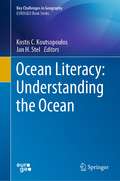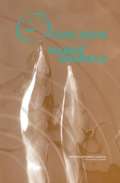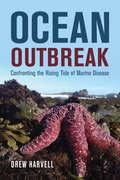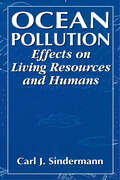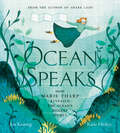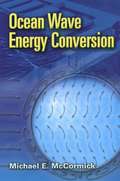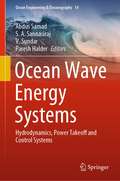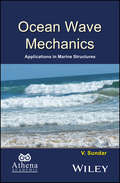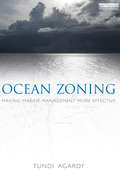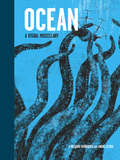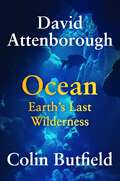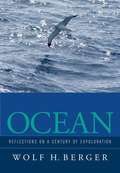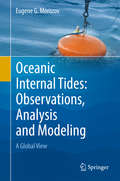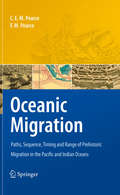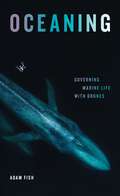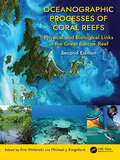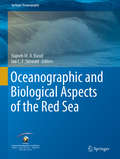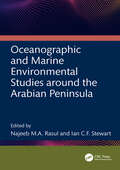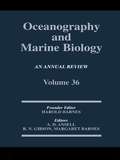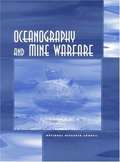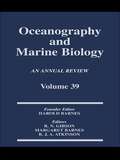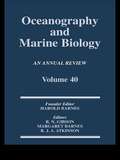- Table View
- List View
Ocean Literacy: Understanding the Ocean (Key Challenges in Geography)
by Kostis C. Koutsopoulos Jan H. StelThis book provides an original review of Ocean Literacy as a component of public policy in Europe and beyond. The impact of the ocean on human activities is one of the most significant environmental issues facing humanity. By offering valuable insights into the interrelationships between geography, environment, marine science and education, the book explores key issues relating to the future of our planet and the way people respond to them. This volume discusses concepts concerning citizenship education and co-creation and the role of public policy and different international initiatives in raising awareness and mitigating the effects of over-use and misuse of valuable resources. A range of innovative projects are presented and evaluated from the local to national and global levels.This book advances knowledge and provides a picture of these advances, presents the issues and challenges, including the important role that geography education and geographical awareness could play in advancing the case for Ocean Literacy.This crossdisciplinary book appeals to students and scientists as well as professionals and practitioners in geography, environmental and marine sciences, international policy and many related fields.
Ocean Noise And Marine Mammals
by Committee on Potential Impacts of Ambient Noise in the Ocean on Marine MammalsFor the 119 species of marine mammals, as well as for some other aquatic animals, sound is the primary means of learning about the environment and of communicating, navigating, and foraging. The possibility that human-generated noise could harm marine mammals or significantly interfere with their normal activities is an issue of increasing concern. Noise and its potential impacts have been regulated since the passage of the Marine Mammal Protection Act of 1972. Public awareness of the issue escalated in 1990s when researchers began using high-intensity sound to measure ocean climate changes. More recently, the stranding of beaked whales in proximity to Navy sonar use has again put the issue in the spotlight. Ocean Noise and Marine Mammals reviews sources of noise in the ocean environment, what is known of the responses of marine mammals to acoustic disturbance, and what models exist for describing ocean noise and marine mammal responses. Recommendations are made for future data gathering efforts, studies of marine mammal behavior and physiology, and modeling efforts necessary to determine what the long- and short-term impacts of ocean noise on marine mammals.
Ocean Outbreak: Confronting the Rising Tide of Marine Disease
by Drew HarvellThere is a growing crisis in our oceans as rates of infectious disease outbreaks are on the rise. Marine epidemics have the potential to cause a mass die-off of wildlife from the bottom to the top of the food chain, impacting the health of ocean ecosystems as well as lives on land. Fueled by sewage dumping, unregulated aquaculture, and drifting plastic in warming seas, ocean outbreaks are sentinels of impending global environmental disaster. Ocean Outbreak follows renowned scientist Drew Harvell and her colleagues as they investigate how four iconic marine animals—corals, abalone, salmon, and starfish—have been devastated by disease. Based on over twenty years of research, this firsthand account of the sometimes creeping, sometimes exploding impact of disease on our ocean’s biodiversity ends with a hopeful message. Through policy changes and the implementation of innovative solutions from nature, we can reduce major outbreaks, save some ocean ecosystems, and protect our fragile environment.
Ocean Pollution: Effects on Living Resources and Humans
by Carl J. SindermannOcean Pollution provides a unique look at the effects of estuarine and coastal pollution on resource species. One of the primary objectives of the book is to provide an accurate assessment of the state of the inshore marine environment and its inhabitants. Coastal habitat degradation is discussed, and principal findings from modeling and other rese
Ocean Speaks: How Marie Tharp Revealed the Ocean's Biggest Secret
by Jess KeatingMeet Marie Tharp (1920-2006), the first person to map the Earth's underwater mountain ridge, in this inspiring picture book biography from the author of Shark Lady.From a young age, Marie Tharp loved watching the world. She loved solving problems. And she loved pushing the limits of what girls and women were expected to do and be. In the mid-twentieth century, women were not welcome in the sciences, but Marie was tenacious. She got a job at a laboratory in New York. But then she faced another barrior: women were not allowed on the research ships (they were considered bad luck on boats). So instead, Marie stayed back and dove deep into the data her colleagues recorded. She mapped point after point and slowly revealed a deep rift valley in the ocean floor. At first the scientific community refused to believe her, but her evidence was irrefutable. She proved to the world that her research was correct. The mid-ocean ridge that Marie discovered is the single largest geographic feature on the planet, and she mapped it all from her small, cramped office.
Ocean Wave Energy Conversion (Dover Civil and Mechanical Engineering)
by Michael E. MccormickThis volume will prove of vital interest to those studying the use of renewable resources. Scientists, engineers, and inventors will find it a valuable review of ocean wave mechanics as well as an introduction to wave energy conversion. It presents physical and mathematical descriptions of the nine generic wave energy conversion techniques, along with their uses and performance characteristics.Author Michael E. McCormick is the Corbin A. McNeill Professor of Naval Engineering at the U.S. Naval Academy. In addition to his timely and significant coverage of possible environmental effects associated with wave energy conversion, he provides a separate treatment of several electro-mechanical energy conversion techniques. Many worked examples throughout the book will be particularly useful to readers with a limited mathematical background. Those interested in research and development will benefit from the extensive bibliography.
Ocean Wave Energy Systems: Hydrodynamics, Power Takeoff and Control Systems (Ocean Engineering & Oceanography #14)
by Abdus Samad V. Sundar S. A. Sannasiraj Paresh HalderThis book offers a timely review of wave energy and its conversion mechanisms. Written having in mind current needs of advanced undergraduates engineering students, it covers the whole process of energy generation, from waves to electricity, in a systematic and comprehensive manner. Upon a general introduction to the field of wave energy, it presents analytical calculation methods for estimating wave energy potential in any given location. Further, it covers power-take off (PTOs), describing their mechanical and electrical aspects in detail, and control systems and algorithms. The book includes chapters written by active researchers with vast experience in their respective filed of specialization. It combines basic aspects with cutting-edge research and methods, and selected case studies. The book offers systematic and practice-oriented knowledge to students, researchers, and professionals in the wave energy sector.Chapters 17 of this book is available open access under a CC BY 4.0 license at link.springer.com
Ocean Wave Mechanics: Applications in Marine Structures (ANE/Athena Books)
by V. SundarThis is a textbook aimed at graduate students and offshore engineering practitioners that covers basic fluid mechanics and the deterministic and statistical descriptions of infinitesimal and finite amplitude water waves. It reviews the theory of wave loading on structures and closes with a chapter on the potential of ocean wave energy and devices for extracting it. Since the 1980s there has been tremendous progress in numerical and physical modelling of coastal and offshore structures in waves. This calls for a clear understanding of the phenomena of wave generation, propagation, deformation and its effects on marine structures. This book will help the reader to understand the many results and descriptions found in journals, reports and research papers. It is self-contained, and encompasses the fundamentals of the subject with sufficient description and illustrations.
Ocean Zoning: Making Marine Management More Effective (Earthscan Oceans Ser.)
by Tundi S. AgardyOur knowledge of the oceans is increasing rapidly, as more powerful tools for exploration and exploitation make it easier to locate valuable resources, such as fish stocks, oil and gas reserves, or sites for wind and hydropower schemes. At the same time competition for space has intensified, affecting marine life and people's livelihoods. Much has been written about marine management using marine protected areas, but MPAs are only a small subset of spatial management tools available. MPAs and MPA networks are better seen as starting points for more comprehensive spatial management, facilitated by ocean zoning. This logical scaling up from discreet piecemeal protected areas to larger and more systematic planning is happening around the world, but few are aware that we are entering a brave new world in ocean management with zoning at its core. This book provides guidance on using ocean zoning to improve marine management. It reviews the benefits of ocean zoning in theory, reviews progress made in zoning around the world through a wide range of case studies, and derives lessons learned to recommend a process by which future zoning can be maximally effective and efficient. Published with MARES, Forest Trends and UNEP
Ocean, Atmosphere, and Climate: Cold Years in New Zealand, Investigation Notebook with Article Compilation
by The Lawrence Hall of ScienceNIMAC-sourced textbook
Ocean, Atmosphere, and Climate: Cold Years in New Zealand, Investigation Notebook with Article Compilation
by The Lawrence Hall of ScienceNIMAC-sourced textbook
Ocean: A Visual Miscellany
by Ricardo Henriques Andre LetriaHalf of our planet is covered by the ocean, yet we've only explored 5 percent of this vast underwater realm. Originally published in Portugal, and awarded a highly coveted BolognaRagazzi Mention by the Bologna Book Fair, this visually compelling miscellany offers readers a tsunami of aquatic facts. Which ocean is the largest? Who was the first explorer to sail around the world? Is the ocean truly blue? Beautifully designed and rich with information, Ocean will satisfy enthusiastic readers who enjoy taking a deep dive into a subject as well as more reluctant readers who prefer to dip in and out of a book.
Ocean: Earth's Last Wilderness
by Sir David Attenborough Colin ButfieldAward-winning broadcaster and natural historian David Attenborough and longtime collaborator Colin Butfield present a powerful call to action focused on our planet's oceans, exploring how critical this habitat is for the survival of humanity and the earth's future. Through personal stories, history and cutting-edge science, Ocean uncovers the mystery, the wonder, and the frailty of the most unexplored habitat on our planet—the one which shapes the land we live on, regulates our climate, and creates the air we breathe. This book showcase the oceans' remarkable resilience: they can, and in some cases have, recovered the fastest, if we only give them the chance. Drawing a course across David Attenborough's own lifetime, Ocean takes readers on an adventure-laden voyage through eight unique ocean habitats, countless intriguing species, and the most astounding discoveries of the last 100 years, to a future vision of a fully restored marine world—one even more spectacular than we could possibly hope for. Ocean reveals the past, present and potential future of our blue planet. It is a book almost a century in the making, but one that has never been more urgently needed.
Ocean: Reflections on a Century of Exploration
by Wolf H. BergerThe past one hundred years of ocean science have been distinguished by dramatic milestones, remarkable discoveries, and major revelations. This book is a clear and lively survey of many of these amazing findings. Beginning with a brief review of the elements that define what the ocean is and how it works--from plate tectonics to the thermocline and the life within it--Wolf H. Berger places current understanding in the context of history. Essays treat such topics as beach processes and coral reefs, the great ocean currents off the East and West Coasts, the productivity of the sea, and the geologic revolution that changed all knowledge of the earth in the twentieth century.
Oceanic Internal Tides: Observations, Analysis and Modeling
by Eugene G. MorozovThis book presents a detailed study of the structure and variability of internal tides and their geographical distribution in the ocean. Based on experimental analysis of oceanic measurements combined with numerical modeling, it offers a comprehensive overview of the internal wave processes around the globe. In particular, it is based on moored buoys observations in many regions in all oceans (Atlantic, Pacific, Indian, Arctic, and Southern) that have been carried out by researchers from different countries for more than 40 years as part of various oceanographic programs, including WOCE and CLIVAR. However, a significant portion of the data was collected by the author, who is a field oceanographer. The data was processed and interpreted on the basis of the latest knowledge of internal wave motion. The properties of internal waves were analyzed in relation to the bottom topography and mean state of the ocean in specific regions. Internal waves play a major role in the formation of seawater stratification and are responsible for the main processes of ocean dynamics, such as energy transfer and mixing. One of the most significant ideas presented in this book is the generation of internal tides over submarine ridges. Energy fluxes from submarine ridges related to tidal internal waves greatly exceed the fluxes from continental slopes. Submarine ridges form an obstacle to the propagation of tidal currents, which can cause the creation of large amplitude internal tides. Energy fluxes from submarine ridges account for approximately one fourth of the total energy dissipation of the barotropic tides. Model simulations and moored measurements have been combined to generate a map of global distribution of internal tide amplitudes. This book is of interest to oceanographers, marine biologists, civil engineers, and scientists working in climate research, fluid mechanics, acoustics, and underwater navigation.
Oceanic Migration
by F. M. Pearce Charles E.M. PearceOceanic Migration studies the prehistoric peopling of the Pacific. It uses science and mathematics to expand the research base of Pacific prehistory and casts new light on this final human expansion. It explores the fundamental roles of oceanography and of global climate change in determining the paths, sequence, timing and range of Spice Island-based maritime migrations ranging across a quarter of the globe. The book is of interest to Pacific prehistorians, oceanographers and American anthropologists concerned with the diffusionist debate. For oceanographers it presents the new idea of the role of the West Pacific Warm Pool and of three of its four major currents in determining the evolution of voyaging in two oceans. For diffusionists it provides new chronological and technological contexts in which the issue of diffusionism needs to be reconsidered. For prehistorians it creates a paradigmatic shift by establishing a new time depth and mechanism for Polynesian exploration, offers a new view of voyaging and exploration strategies and of economic imperatives and adds a new dimension to the debate on Polynesian origins.
Oceaning: Governing Marine Life with Drones (Elements)
by Adam FishDrones are revolutionizing ocean conservation. By flying closer and seeing more, drones enhance intimate contact between ocean scientists and activists and marine life. In the process, new dependencies between nature, technology, and humans emerge, and a paradox becomes apparent: Can we have a wild ocean whose survival is reliant upon technology? In Oceaning, Adam Fish answers this question through eight stories of piloting drones to stop the killing of porpoises, sharks, and seabirds and to check the vitality of whales, seals, turtles, and coral reefs. Drone conservation is not the end of nature. Instead, drone conservation results in an ocean whose flourishing both depends upon and escapes the control of technologies. Faulty technology, oceanic and atmospheric turbulence, political corruption, and the inadequacies of basic science serve to foil governance over nature. Fish contends that what emerges is an ocean/culture—a flourishing ocean that is distinct from but exists alongside humanity.
Oceanographic Processes of Coral Reefs: Physical and Biological Links in the Great Barrier Reef
by Eric Wolanski Michael J. KingsfordIn the last two decades since publication of the first edition, substantial advancements have been made in the science, the need for transdisciplinary approaches to coral reef protection greater than ever before. This new edition, now in full color throughout with accompanying animations, goes beyond identifying foundational information and current problems to pinpoint science-based solutions for managers, stakeholders and policy makers. Coral reefs are connected by currents that carry plankton and the larvae of many reef-based organisms. Further, they supply food to reefs. Currents also bring pollutants from the land and, together with the atmosphere, affect the surrounding ocean. The chapters in this book provide a much-needed review of the biophysics of reefs with an emphasis on the Great Barrier Reef as an ecosystem. The focus is on interactions between currents, waves, sediment and the dynamics of coastal and reef-based ecosystems. The topographic complexity of reefs redirects mainstream currents, creates tidal eddies, mushroom jets, boundary layers, stagnation zones, and this turbulence is enhanced by the oceanographic chaos in the adjoining Coral Sea. This is the environment in which particles and organisms, of a range of sizes live, from tiny plankton to megafauna. This generates faunal connectivity at scales of meters to thousands of km within the Great Barrier Reef and with the adjoining ocean. Pollution from land-use is increasing and remedial measures are described both on land and on coral cays. The impact of climate change is quantified in case studies about mangroves and corals. Modelling this biophysical complexity is increasing in sophistication, and the authors suggest how the field can advance further.
Oceanographic and Biological Aspects of the Red Sea (Springer Oceanography)
by Najeeb M.A. Rasul Ian C.F. StewartThis book includes invited contributions presenting the latest research on the oceanography and environment of the Red Sea. In addition to covering topics relevant to research in the region and providing insights into marine science for non-experts, it is also of interest to those involved in the management of coastal zones and encourages further research on the Red Sea
Oceanographic and Marine Environmental Studies around the Arabian Peninsula
by Najeeb M.A. Rasul Ian C.F. StewartOceanographic and Marine Environmental Studies around the Arabian Peninsula presents studies on a range of topics related to the marine environment of the Red Sea and Arabian (Persian) Gulf.This book contains invited and peer-reviewed chapters from diverse researchers active in their respective fields. The chapters offer new data and include a comprehensive lists of references. Some of the main topics included in the book are pollution from heavy metals and petroleum, hydro-environmental characteristics of the seas, conservation of marine ecosystems, risk of climate change on the Red Sea region, and the mangrove environment.With new developments occurring in the coastal regions in recent decades, the book will be not only a helpful resource to researchers but also be a valuable reference for anyone curious about managing the marine and littoral environment of these two unique seas.
Oceanography And Marine Biology: Volume 36 (Oceanography And Marine Biology Ser. #Vol. 36)
by Margaret Barnes R. N. Gibson Harold Barnes A. D. AnsellOceanography and Marine Biology: an Annual Review considers basic areas of marine research, returning to them when appropriate in future volumes, and deals with subjects of special and topical importance in the field of marine biology. The thirty-sixth volume follows closely the objectives and style of the earlier well recieved volumes, conti
Oceanography And Mine Warfare
by National Research CouncilBased on a 1999 symposium, this report reviews how oceanographic data are used in US mine warfare, and the current and future capability of research to enhance such operations. Coverage includes doctrine, training issues, data collection/database capabilities, and modeling capabilities. Appends information on the symposium, a wargame scenario, the Office of Naval Research Program, and supporting research programs. Lacks an index. Annotation c. Book News, Inc. , Portland, OR (booknews. com)
Oceanography and Marine Biology, An Annual Review, Volume 39: An Annual Review: Volume 39 (Oceanography And Marine Biology - An Annual Review Ser.)
by Margaret Barnes R. N. Gibson R. J. A. AtkinsonInterest in oceanography and marine biology and the relevance of those fields to global environmental issues creates a demand for authoritative reviews that summarize recent research. Oceanography and Marine Biology: an Annual Review has catered to this demand since its foundation, by the late Harold Barnes, more than 35 years ago. It is an annual
Oceanography and Marine Biology, An Annual Review, Volume 40: An Annual Review: Volume 40 (Oceanography And Marine Biology - An Annual Review Ser.)
by Margaret Barnes R. N. Gibson R. J. A. Atkinson Harold BarnesInterest in oceanography and marine biology and its relevance to global environmental issues continues to increase, creating a demand for authoritative reviews that summarize recent research. Oceanography and Marine Biology: An Annual Review has catered to this demand since its foundation, by the late Harold Barnes, more than 40 years ago. It is an
